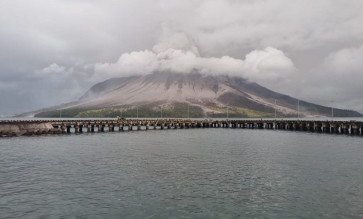Vast, zombie-like microbial life lurks beneath seabed
Change Size
 This undated handout photo courtesy of Gaetan Borgonie (Extreme Life Isyensya, Belgium, Deep Carbon Observatory, obtained December 10, 2018 shows a nematode (eukaryote) in a biofilm of microorganisms, an unidentified nematode (Poikilolaimus sp.) from Kopanang gold mine in South Africa,which lives 1.4 km below the surface. About 70 percent of the Earth's microbes live in its depths, in rocks once considered barren but where bacteria and other unicellular organisms abound. For the first time, researchers have estimated the extent of this deep life or 'intraterrestrial'. (AFP/Gaetan Borgonie)
This undated handout photo courtesy of Gaetan Borgonie (Extreme Life Isyensya, Belgium, Deep Carbon Observatory, obtained December 10, 2018 shows a nematode (eukaryote) in a biofilm of microorganisms, an unidentified nematode (Poikilolaimus sp.) from Kopanang gold mine in South Africa,which lives 1.4 km below the surface. About 70 percent of the Earth's microbes live in its depths, in rocks once considered barren but where bacteria and other unicellular organisms abound. For the first time, researchers have estimated the extent of this deep life or 'intraterrestrial'. (AFP/Gaetan Borgonie)
S
cientists have drilled a mile and a half (2.5 kilometers) beneath the seabed and found vast underground forests of "deep life," including microbes that persist for thousands, maybe millions of years, researchers said Monday.
Feeding on nothing but the energy from rocks, and existing in a slow-motion, even zombie-like state, previously unknown forms of life are abundant beneath the Earth despite extreme temperatures and pressure.
About 70 percent of Earth's bacteria and archaea -- single-celled organisms with no nucleus -- live underground, according to the latest findings of an international collaboration involving hundreds of experts, known as the Deep Carbon Observatory, were released at the American Geophysical Union meeting in Washington.
This "deep life" amounts to between 15 and 23 billion tons of carbon, said the DCO, launched in 2009, as it nears the end of its 10-year mission to reveal Earth's inner secrets.
"The deep biosphere of Earth is massive," said Rick Colwell, who teaches astrobiology and oceanography at Oregon State University.
He described the team's findings so far as a "very exciting, extreme ecosystem."
Among them may be Earth's hottest living creature, Geogemma barossii, a single-celled organism found in hydrothermal vents on the seafloor.
Its microscopic cells grow and replicate at 250 degrees Fahrenheit (121 Celsius).
"There is genetic diversity of life below the surface that is at least equal to but perhaps exceeds that which is at the surface and we don't know much about it," Colwell said.
'Distinct' from surface life
Similar types of strange, deep life microbes might be found on the subsurface of other planets, like Mars.
"Most of deep life is very distinct from life on the surface," said Fumio Inagaki, of the Japan Agency for Marine-Earth Science and Technology.
Read also: Farmers, researchers step in to eliminate ‘Black River's’ smell
Using the Japanese scientific vessel Chikyu, researchers have drilled far beneath the seabed and removed cores that have given scientists a detailed look at deep life.
"The microbes are just sitting there and live for very, very long periods of time," he told AFP.
Brought up from these ancient coal beds and fed glucose in the lab, researchers have seen some microbes, bacteria and fungi slowly waking up.
"That was amazing," said Inagaki.
Scientists have found life in continental mines and boreholes more than three miles (five kilometers) deep, and have not yet identified the boundary where life no longer exists, he added.
How basic biology works?
Gaining a better understanding of subsurface life on Earth can also help understand and better engineer climate-change fighting technologies that may one day sequester carbon from the atmosphere.
"What we learn here will help us understand what to look for on other planets or other systems where life could exist," said Colwell.
In any case, studying what some scientists have called the "Galapagos of the Deep," dramatically changes human's perception of life on Earth, and their place in it.
Most of our planet's microbial life is deep beneath the surface, and it may have played a big part in the evolution of Earth's atmosphere by locking carbon dioxide underground and allowing air for people and animals to breathe.
"There is lots and lots of life on Earth that we did not know about. The fact that so much of it -- at least in the marine sediment -- is functioning at extremely low energy, it really changes our basic conception of how biology works," said Karen Lloyd, an associate professor at the University of Tennessee at Knoxville.
"They are new branches on the tree of life that have been on Earth, doing whatever it is that they do, for billions of years, but without us ever noticing them," she told AFP.
"It is like looking beside you and finding that you have an officemate you never knew about."








